Why Your Internal Teams Will Love Webflow
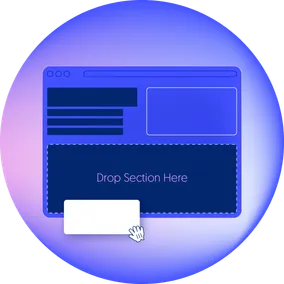
Ismael Lopez, Former Senior Visual Designer
Article Categories:
Posted on
It feels like we’ve returned to the early days of website building with how easily Webflow lets you build your own functional and high-polish website.
Every year, it seems like there's a new tool that revolutionizes how we structure our projects. Figma streamlined design and development workflows, while Notion consolidated project management tools into a single workspace. This time, we think it's Webflow.
Webflow is the No-Code Web Builder
No-code website builders are not a new concept. Since 2003, companies like WordPress, Squarespace, Wix, and others have competed to be the most user-friendly website builders, offering out-of-the-box templates that enable anyone to quickly create a landing page or storefront for their company.
Webflow, however, is *not* that kind of tool.
To a non-designer or developer, Webflow may not seem user-friendly. Instead, Webflow is a bridge between the two professions, allowing designers to build pixel-perfect websites from their original Figma designs in a matter of days. Additionally, a designer can make follow-up design changes in minutes rather than hours, freeing up the development team to create value for your product or service. If you can design it, you can build it with Webflow.
How Webflow Works for Lattice
Webflow can be a very appealing tool for marketing teams who need to spin up a visually appealing and branded microsite to accompany their product upon launch. Lattice, an HR product that we use here at Viget, is a great example of a company that utilizes Webflow for its marketing needs. When the Lattice marketing team began to explore low-lift and flexible ways for their team to keep their marketing content updated and fresh, they found Webflow, which allowed them to expedite website and content updates in less than half the time than a traditional development build process.
Lattice.com
When Lattice was founded in 2015, they coded their website from scratch and connected it to a headless CMS. This allowed Lattice’s marketing team to have a great level of control on their content, but the front end, specifically when it came to creating new pages and templates, remained a development-led process, blocking the team from being quick and nimble. The team often opted to hire a freelance developer to push the needed changes, but this cost tens of thousands of dollars a year and still took weeks for updates to go live on the site.
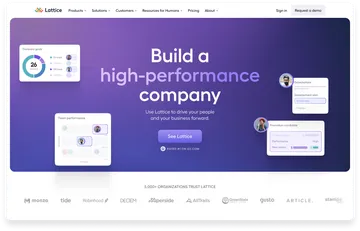
To address this issue, the team at Lattice began with some proofs of concept to gain insight into how Webflow could fit into their workflows. The results were promising: by not having to worry about technical challenges, marketing teams were able to focus on the larger brand strategy. By enabling individual members of the team to own parts of their own website, Lattice was able to cut development from the process entirely and create new pages in a week or less, a significant improvement from the month-long build time of traditional development. Of course, this also meant that the development team was able to give their focus on the core product, providing the most value to the company.
All in all, the process of redesigning and rebuilding the website took a partner Webflow designer just one month to build the website and an additional month of onboarding for the marketing team’s designer to fully take over the site.
Resources for Humans
One of my favorite marketing trends of the past few years is the proliferation of in-house publications and robust resource libraries created by marketing teams. Because of the flexibility of the Webflow CMS, it can be a very appealing tool for teams who need to spin up these type of microsites to accompany their product upon launch.
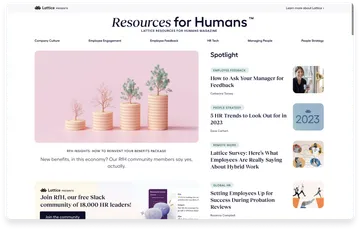
After the main website was launched, the marketing team was empowered to become more ambitious and imaginative with their marketing efforts. With the power and customization of Webflow’s native CMS, the Lattice team was able to create a resource library targeted at HR professionals that fit the needs of the team. The ability to add custom code and SEO terms to webpages meant the Lattice content team was able to test their content and measure analytics, eventually resulting in a 280% increase in organic traffic.
Other Users
Lattice isn’t the only company to utilize the capabilities of Webflow, but it is certainly one of the few that rely on it for its end-to-end web marketing efforts. Hellosign, now Dropbox Sign, built its entire site on Webflow. Even after their acquisition in 2019 and rebranding, the team still uses Webflow for their marketing needs.
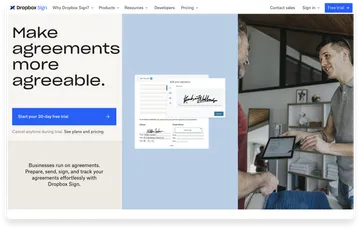
Discord and Cameo use Webflow to quickly create audience-specific landing pages that are able to speak to the needs of a small, targeted audience. Upwork and Spotify created resource libraries for their customers. Upwork’s library is general and focused on general HR content, much like Lattice, and Spotify’s library is specifically targeted to podcasters, an emerging business segment for the company.
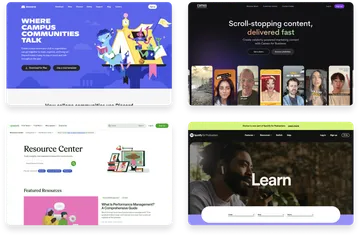
A robust community of support
I cannot stress just how many first-party support materials exist for Webflow. Better still, most of the fundamental learning resources come in the form of thorough and frankly, very entertaining videos. Webflow has even curated a series of videos, appropriately titled “Webflow 101,” to help internal teams understand the ins and outs of the platform.
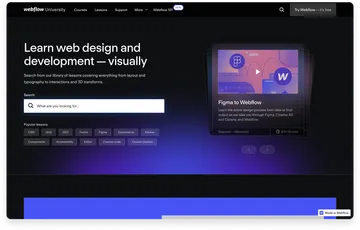
Of course, there are larger topics that you may have questions about that aren’t about the core Webflow product: strategy, personalization, design documentation, security, custom code—everyday things that you think about with any website. This is where the larger Webflow community comes in.
There has never been an instance where I could not find a solution for one of my Webflow problems on YouTube. In fact, there are so many creators making Webflow content that Webflow had the idea to create a platform to house original productions from content partners.
It’s safe to say that you’re in good hands with the Webflow community.
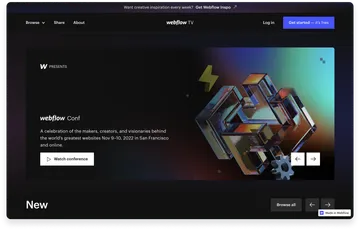
Getting Started
Webflow is designed to be a flexible platform for designers and content authors. Marketing teams can create professional, stand-alone websites in less than half the time of a traditional development process and create a unique customizable CMS that meets the needs of content teams at the same time. Nimble and innovative teams will enjoy the innovative opportunities that will unlock as a result of adopting Webflow, be it on their primary marketing website, or through bespoke landing pages and spinoff brands.
At Viget, we see an opportunity with startup companies that are focused on their MVPs, but don’t have a website that aligns with the polish of their product. With Webflow, our design team is able to quickly create a scalable landing page for the product without needing to pull a member of the development team from building the MVP. This makes it easier to deliver a key piece of the product marketing funnel at the same level of fidelity you expect from the software itself.
Have you been wondering if Webflow is a good fit for your needs? Get in touch to explore the possibilities with our team.